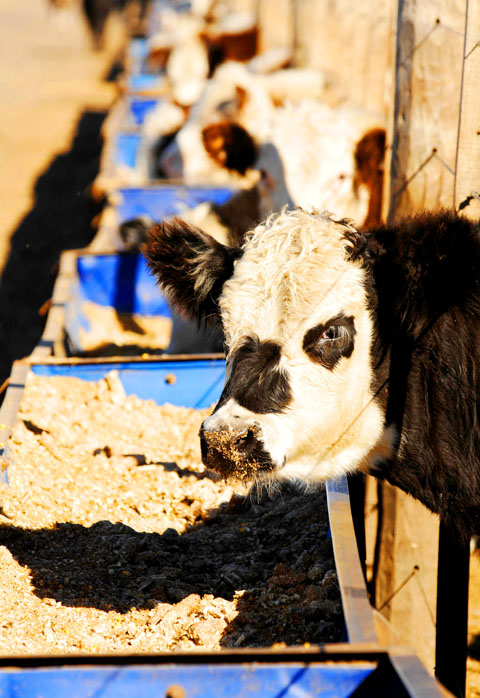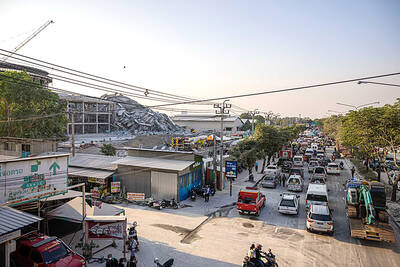For 100 years, cattle breeders refined their beef on the vast Argentine grasslands.
With the help of mild winters, regular rainfall and fertile soil, ranchers grazed top-notch British breeds like Hereford and Angus on rich grasses, producing meat with a texture and taste craved throughout the world.
“Argentina is to beef what Cuba is to cigars,” says Juan Pablo Thieriot, co-founder of Estancia Beef, which exports Argentine and Uruguayan grass-fed meat.

PHOTO: AP
But soaring world food prices may spell the end of the great Argentine steak.
Demand for grain and soy is pushing Argentine ranchers to till their pastures in crops. Cattle that once roamed the pampas are increasingly fattened on corn in cramped feedlots instead. Top beef producers are being pushed toward a system that has been criticized in the US for putting cattle in unnatural environments and creating meat with a mass-produced taste.
About 30 percent of Argentine cattle now finish their lives in feedlots, the Argentine Feedlot Chamber said. Ten or fifteen years ago, that number was zero.
“Ranching here is going from an artisan craft, based on grass, to a more industrial system, similar to the United States,” said Eduardo Pereda, whose family founded the Nueva Castilla ranch in Trenque Lauquen in 1883.
Nueva Castilla now devotes vast tracts of land to corn and sunflowers, while thousands of cattle are crowded into mud-floored corrals lined with plastic feeding troughs.
Three years ago, about half the ranch’s arable land was devoted to pasture. Today, that number is below 9 percent. This year will be the first that some of Nueva Castilla’s animals never see pasture.
Feedlot cattle are now two-and-a-half to three times more profitable than those raised on pasture when combined with crop production.
“One hectare in crops brings in US$500 per year,” said Pablo Tassone, who oversees the Nueva Castilla herd of 24,000 head. “A hectare in pastured beef, if you’re really good, won’t bring in more than US$200.”
Tassone said feedlot beef does tend to be fattier than grass-fed meat. But by feeding his cattle primarily corn husks, he says, he can produce beef that is practically the same quality while meeting the pressures of an international market.
“We’re giving them food much like what they eat in pasture,” he said. “But they grow faster this way.”
Other major beef exporters such as Brazil and Australia are joining the trend, which is also fueled by rising beef consumption worldwide as middle-class incomes and tastes take hold in developing countries. Corn-fed cows in lots where they can’t roam fatten quicker. In the last 10 years, Australia has seen about a 50 percent hike in the number of cattle on feed instead of grass, while Brazil has seen a threefold increase.
The change so far will have little impact in the US, which bans imports of raw Argentine beef because of concerns about foot-and-mouth disease. Argentina says it has eradicated the disease and that the ban has more to do with politics than health.
The country’s best steaks are sent to Europe under the EU’s Hilton Quota, which regulates the import of top quality beef — always grass-fed — from a number of places. Argentine steaks fetch the highest prices under the quota and make up the majority of beef imports, Thieriot said.
Argentina’s switch to crops started about a decade ago with the introduction of new technology, including genetically modified crops and no-till farming, a technique that prevents erosion and improves moisture retention in soil. The trend accelerated as international prices for grain and other commodities began to rise in 2002 and have soared in the last two years.
When the Argentine government implemented price controls and export bans to keep domestic beef prices low, even more ranchers switched to farming. The government began subsidizing feedlots to ensure a steady supply of beef to Argentines, who lead the world in beef consumption at an average of 65kg a year.
US agribusiness sees opportunities in Argentina’s switch from ranching to farming. Last year, Tyson Foods said it planned to expand feedlot capacity in central Argentina, investing in a 25,000-head lot jointly run by Cresud, an Argentine agribusiness, and Cactus Feeders, a Texas-based operator.
In the US, feedlots have been criticized for their use of growth hormones and antibiotics. But in Argentina, hormones are banned by the government, and antibiotic use is at a minimum.
Some longtime fans say they can tell the difference. Malcolm Harris began importing Argentine beef to the UK under the label Pampas Plains five years ago because he missed the meat after living in Argentina for five years.
“It was like an itch I couldn’t scratch,” he said.
He said he was disappointed on his most recent trip to Argentina.
“Years ago, I never had a bad steak in Argentina,” Harris said. “This year was the first.”
Also See: Eat less meat to save the world

AIR SUPPORT: The Ministry of National Defense thanked the US for the delivery, adding that it was an indicator of the White House’s commitment to the Taiwan Relations Act Deputy Minister of National Defense Po Horng-huei (柏鴻輝) and Representative to the US Alexander Yui on Friday attended a delivery ceremony for the first of Taiwan’s long-awaited 66 F-16C/D Block 70 jets at a Lockheed Martin Corp factory in Greenville, South Carolina. “We are so proud to be the global home of the F-16 and to support Taiwan’s air defense capabilities,” US Representative William Timmons wrote on X, alongside a photograph of Taiwanese and US officials at the event. The F-16C/D Block 70 jets Taiwan ordered have the same capabilities as aircraft that had been upgraded to F-16Vs. The batch of Lockheed Martin

GRIDLOCK: The National Fire Agency’s Special Search and Rescue team is on standby to travel to the countries to help out with the rescue effort A powerful earthquake rocked Myanmar and neighboring Thailand yesterday, killing at least three people in Bangkok and burying dozens when a high-rise building under construction collapsed. Footage shared on social media from Myanmar’s second-largest city showed widespread destruction, raising fears that many were trapped under the rubble or killed. The magnitude 7.7 earthquake, with an epicenter near Mandalay in Myanmar, struck at midday and was followed by a strong magnitude 6.4 aftershock. The extent of death, injury and destruction — especially in Myanmar, which is embroiled in a civil war and where information is tightly controlled at the best of times —

China's military today said it began joint army, navy and rocket force exercises around Taiwan to "serve as a stern warning and powerful deterrent against Taiwanese independence," calling President William Lai (賴清德) a "parasite." The exercises come after Lai called Beijing a "foreign hostile force" last month. More than 10 Chinese military ships approached close to Taiwan's 24 nautical mile (44.4km) contiguous zone this morning and Taiwan sent its own warships to respond, two senior Taiwanese officials said. Taiwan has not yet detected any live fire by the Chinese military so far, one of the officials said. The drills took place after US Secretary

THUGGISH BEHAVIOR: Encouraging people to report independence supporters is another intimidation tactic that threatens cross-strait peace, the state department said China setting up an online system for reporting “Taiwanese independence” advocates is an “irresponsible and reprehensible” act, a US government spokesperson said on Friday. “China’s call for private individuals to report on alleged ‘persecution or suppression’ by supposed ‘Taiwan independence henchmen and accomplices’ is irresponsible and reprehensible,” an unnamed US Department of State spokesperson told the Central News Agency in an e-mail. The move is part of Beijing’s “intimidation campaign” against Taiwan and its supporters, and is “threatening free speech around the world, destabilizing the Indo-Pacific region, and deliberately eroding the cross-strait status quo,” the spokesperson said. The Chinese Communist Party’s “threats